Places of Interest (Sights, Historical Sights)
Daisen has many historical sights, temples and shrines due to its favorable location for trade and these areas of interest reflect the rich lifestyles of the area.
We hope you will enjoy the many flavors of Daisen.
1. National Historical Sight (The ancient wall of Hotta)
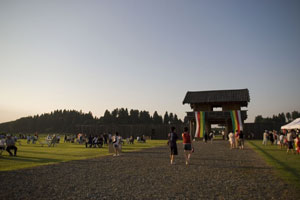
Location: Hotta Aza, Nakayachi,
Contact: Hottanosaku General Information Bureau
Telephone: 0187-69-2397
Basic Outline
This landmark is known as the remnants of an ancient city from the start of the Heian period. If you make a booking it is possible to learn the history from one of the staff.
Detailed Description
In ancient wall of Hotta was constructed approximately 1,200 years ago, at the start of the Heian Period and a National Statue was erected in unification of the area. Today these relics are now held by the military affairs and government office.
The outside wall is a 3.6m high, 30cm wide made of wooden blocks. It is a large-scale ruin stretching 3.6km northeast and covers an area of 87.8ha.
Research of the annual growth rings of the wooden blocks used for the foundations have proved that they were felled around 801AD thus determining that the The Ancient wall of Hotta was established around that era. However, there are no detailed records in relation to the wall in ancient documents and the historical name is yet to be determined as there are many questions still to be answered.
2. National Treasure (One-thousand armed statue of Kannon)
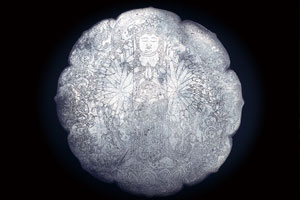
Location: Toyokawa Water Temple
Contact: Nakasen General Information Branch Office
Telephone: 0187-56-2111
Outline
The Toyokawa Water Temple is Akita prefecture's sole National Treasure. Around the 11th century the eight legions of Kannon was engraved in a bronze mirror based on the One Thousand Arm image of Kannon (the Buddhist deity of mercy). The image is now displayed at Donparu.
Although there are many Temples that worship water throughout Japan, the water temple at Toyokawa in Daisen City is the sole water temple in Akita Prefecture. The engraved one thousand arm image of Kannon and is designated a national treasure and has been enshrined as a spiritual deity.
This spiritual deity is displayed once a year on August the 17th creating excitement throughout the local community.
3. National Sight (Ikedashi Garden)
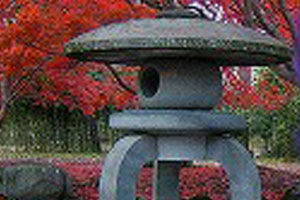 Location: Takanashi Aza Ooshima Location: Takanashi Aza Ooshima
Contact: Cultural Preservation Department
Telephone: 0187-63-8972
Outline
Ikedashi Garden was designated a National Scenic Place of Beauty in 2004, the first National Scenic Place of Beauty in Akita Prefecture. The Ikeda family is known as one of the major landowners of Northern Japan and their 42,000m2 property boasts ancient buildings reflecting the life and times of the Meiji through to the Taisho period.
Usually the garden is not open to the public, however special exhibitions are held twice a year.
4. Akita Prefecture Agricultural Science Museum
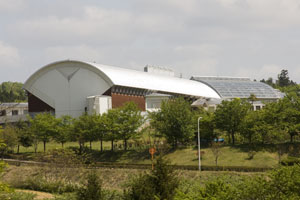 Location: Uchiotomo Aza Nakazawa Location: Uchiotomo Aza Nakazawa
Contact: Akita Prefecture Agricultural Science Museum
Telephone: 0187-68-2300
Outline
The museum displays agricultural historic and modern technology including biotechnology. There is also a year round giant hothouse displaying plants from throughout the world.
Detailed description
The Agricultural Science Museum has a theme park like atmosphere where learning about agriculture is fun. The state of the art diorama and three-D image display is the first of its kind and offers a straightforward introduction to biotechnology. Explore at leisure the giant hothouse, orchard, arboretum and beautiful spacious lawns.
5. Mahoroba Karamatsu Noh Theater
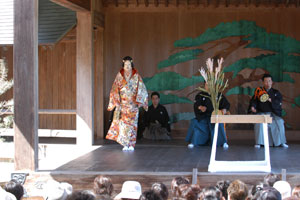 Location: Sakai Aza, Karamatsudake, Kyowa Location: Sakai Aza, Karamatsudake, Kyowa
Contact: Mahoroba Karamatsu (Noh Theater)
Telephone: 018-892-3500
Outline
The only legitimate Noh Theater in Akita Prefecture. Based on West Kyoto's Honganji Noh stage the Mahoroba Karamatsu Noh Theater holds regular Noh performances.
6. Designated National Cultural Asset (Koshio Shrine)
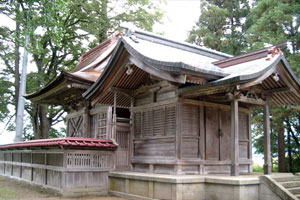
Location- Koshiogiwa, Omagari Aza
Contact- Cultural Preservation Department
Telephone- 0187-63-8972
Outline
Constructed by the craftsman Hida, the shrines dynamic structure depicts the characteristics of elegant sculpture and Japanese design. The shrine is representing architecture of the Muromachi Era.
Detailed Description
Koshio Shrine is located at Takabatake in Koshougiwa, 15 minutes drive from Omagari station. It is told that the shrine was constructed by the seventh generation of the Togashi Saemon Tarokatsu House, under the instruction of feudal lord Tozawa Hyobu at the beginning of the Genki Period. It has been ascertained that the shrine was construction by the craftsman Hida.
The shrine is referred to as "Architecture representing the Muromachi Era" due to its dynamic design of elegant sculpture, and was designated a National Cultural Asset in August of 1950. The main building's upper construction, decoration under the eaves, the bas-relief chrysanthemum carving in the main hall and the curved wooden support and craftsmanship of the railing posts are well worth seeing.
7. Karamatsu Shrine Amatsuhinmiya
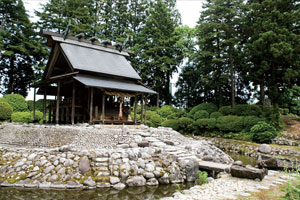 Location: Sakai Aza, Shitadai, Kyowa Location: Sakai Aza, Shitadai, Kyowa
Contact: Karamatsu Shrine Omatsuhinmiya
Telephone: 018-892-3002
Outline
The Karamatsu Shrine is a shrine that is steeped in history. It is famous for worshiping the God of fertility and safe childbirth and people from throughout the country come to pay homage to the gods. The shrine worships the Shinto God Mononobe.
Detailed Description
During the Edo period the princess from the Satake fiefdom was suffering in her last months of pregnancy. She went to the goddess of Karamatsu in Semboku, the kingdom of Dewa where the maiden of Okinagatarashi and the empress of Jinguukogo were enshrined and asked for the gods to end her suffering. At that very moment the vassals were praying for the princess's safe birth a healthy baby boy was born. It is said that the princess performed a Shinto dance and presented the shrine with a snakes-head dancing mask as an expression of gratitude. Today the ancient mask is preserved as a Prefectural Cultural Asset.
Since ancient times Karamatsu has been well known as a god of safe birth and child bearing. The word of the Shinto priests from the Mononobe family has ascended through the records of ancient matters and thus ancient history has survived until present day. Of course not only people from Akita prefecture, but also people from all over the country come to pay homage to the Karamatsu Shrine.
8. Mochinoyakata (Rice-cake Hall)
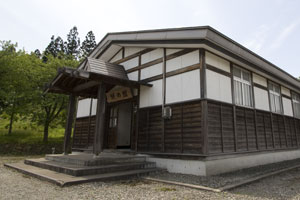 Location-Itaminai Aza, Hitotsumori Location-Itaminai Aza, Hitotsumori
Telephone-0187-69-3365
Outline
The hall offers an introduction to rice-cakes from throughout Japan and also has information on rural culture and annual events related to the making of rice-cakes. The display is the only display of its type in Japan and has over 400 varieties of rice-cake.
Detailed Description
Senboku area has been a rice producing area since before written history. The rice-cake hall is situated near the middle of the Senboku plains in Akita Prefecture. Since long ago the rural community has held rice-pounding festivals and consume large amounts of rice cake throughout the year. Rice-pounding festivals were held to celebrate new years, autumn break at the end of the autumn rice harvest, and to celebrate ones health with grilled rice cakes on December the 8th. Nowadays rice-pounding festivals and the chance to eat rice-cakes are decreasing. However at the Rice-cake hall one can view the rice pounding and the processing of rice-cakes and experience rural culture. The display is the only display of its type in Japan and has over 400 varieties of rice-cake. Try your hand at making rice-cakes in the round building next door and enjoy the three steps of eating rice-cakes watch, pound and eat. We look forward to seeing you.
|